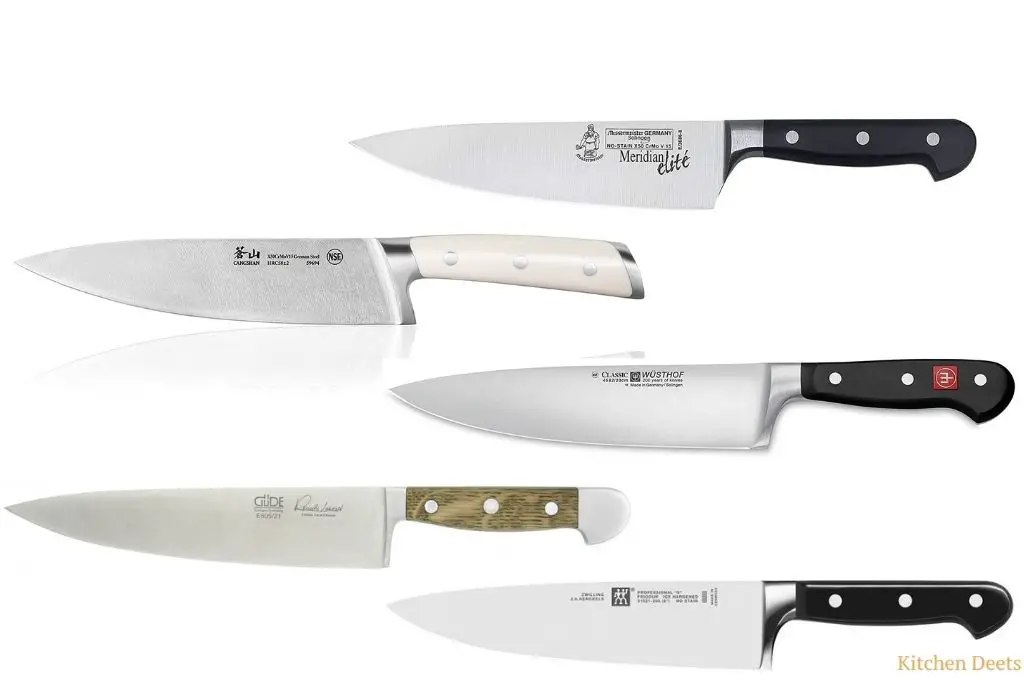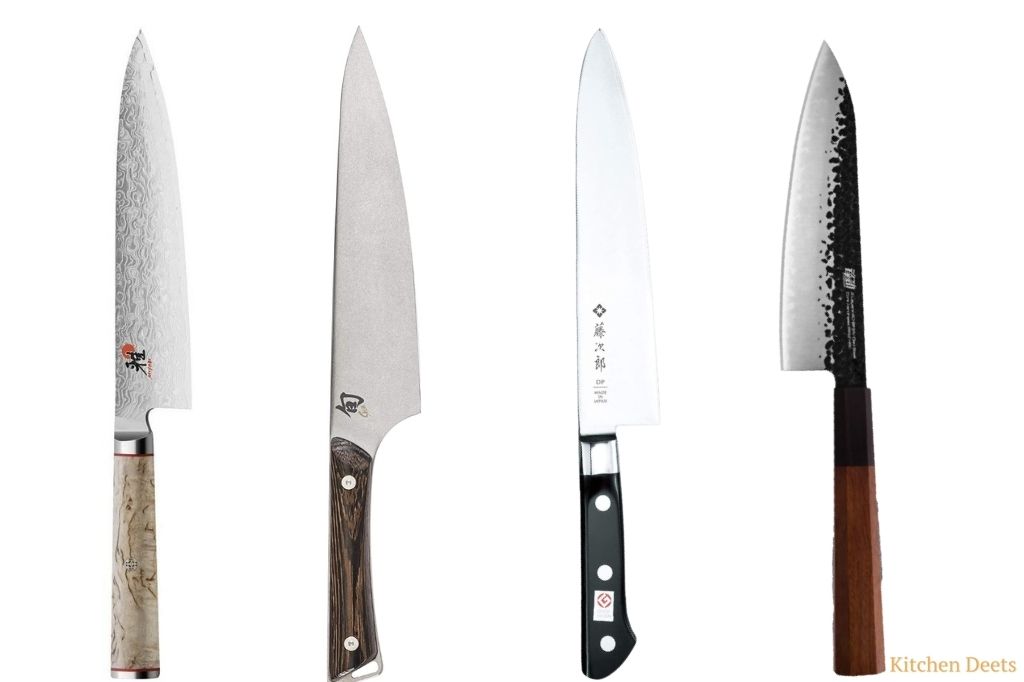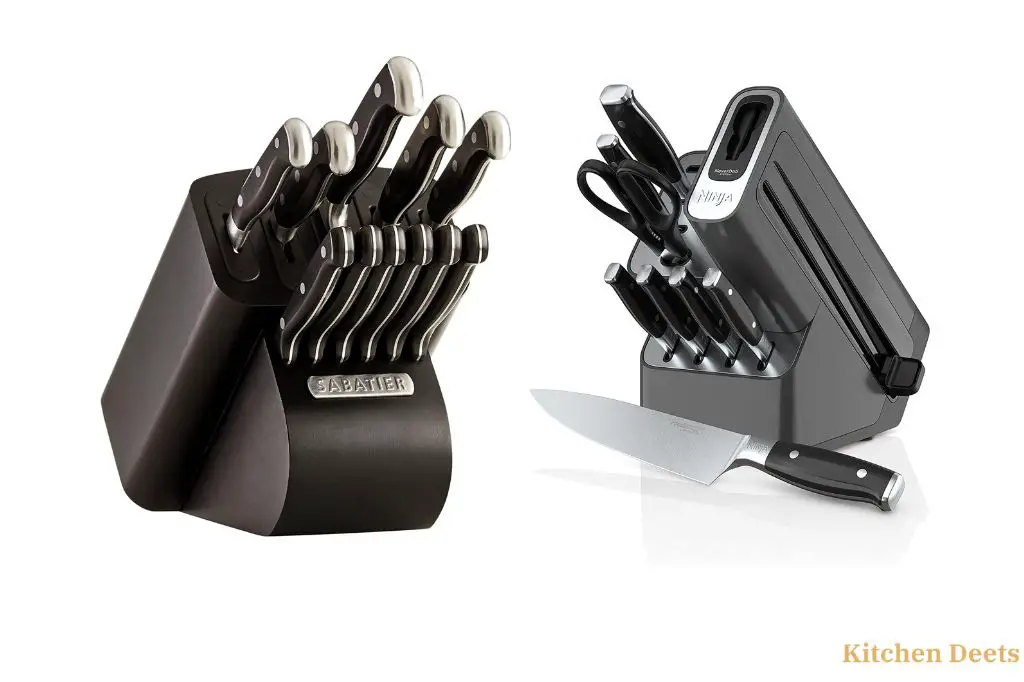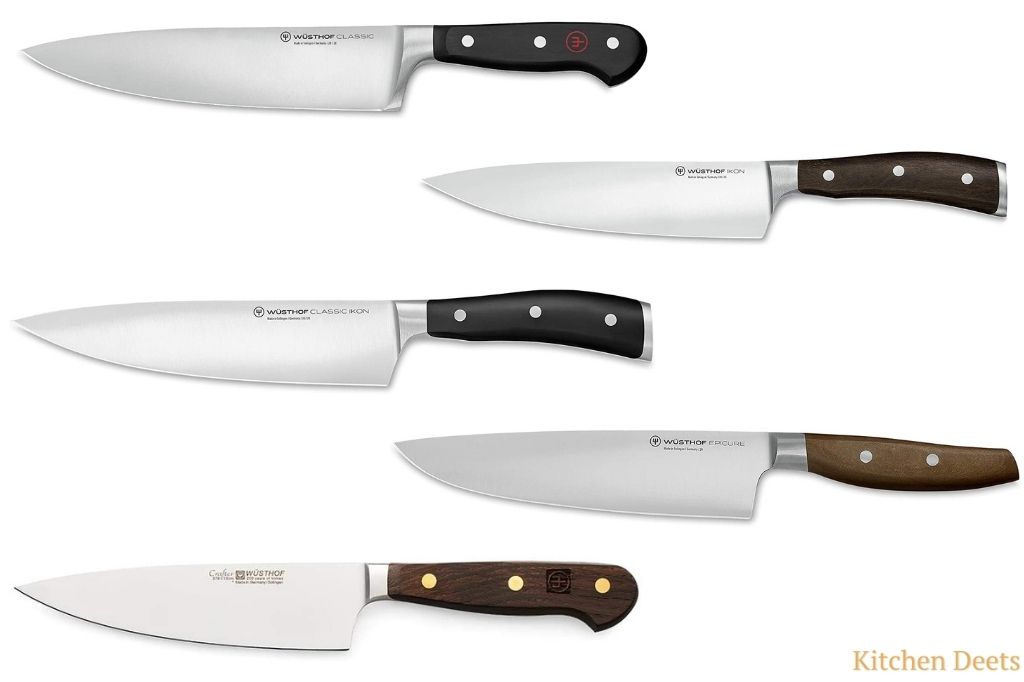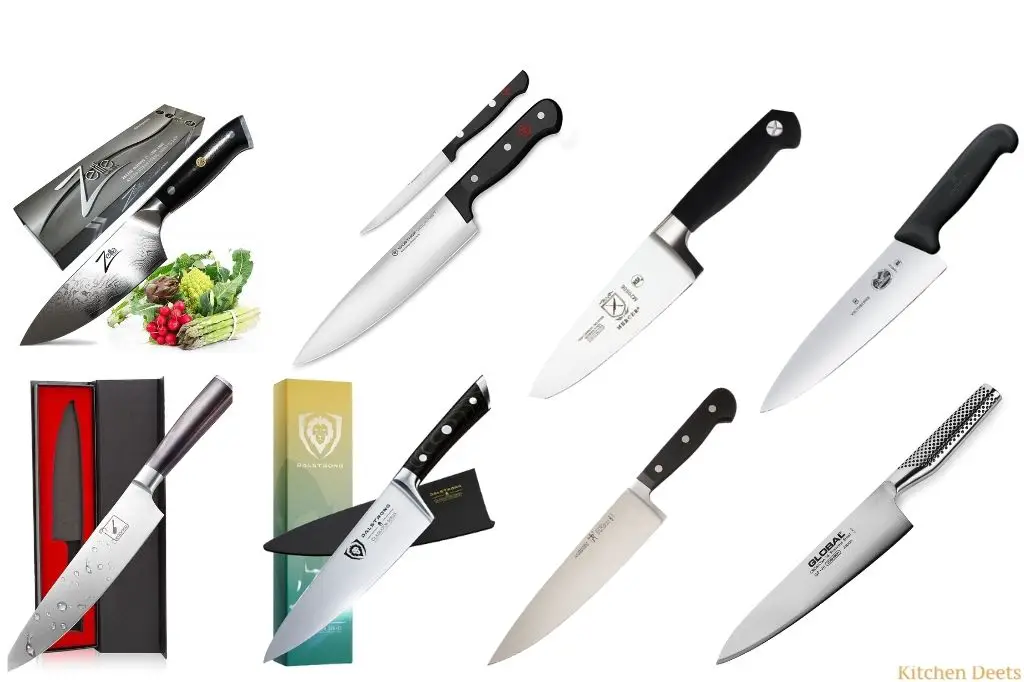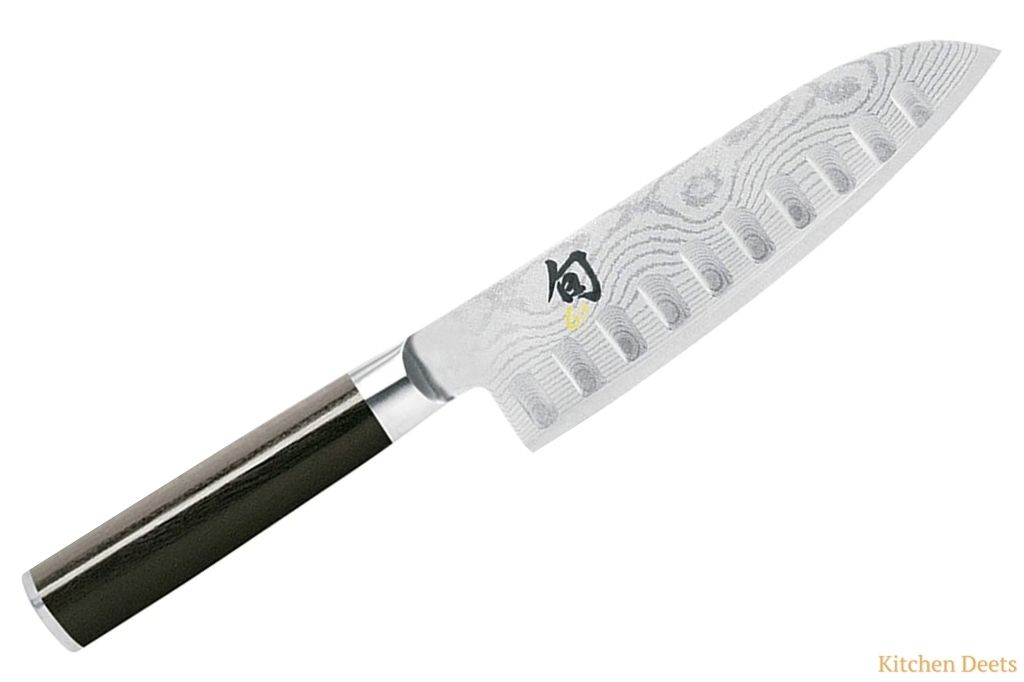When it comes to kitchen knives, a lot of people tend to think that Japanese and German knives are the same. Sure, they have different shapes, sizes, colors, and types — but do they really differ in quality and performance?
While both Japanese and German knives are sharpened to super-sharp edges, they each have unique characteristics that set them apart from each other.
Let’s take look at the Best German knives that made to our list, and see what makes them so unique.
Click on the links below for easy navigation.
- Wüsthof Classic 8 Inch Knife – Best Overall Knife
- Zwilling J.A. Henckels Professional S 8 inch – Best Professional Kitchen Knife
- Mercer Culinary Renaissance 8 Inch Chef Knife – Best Budget Knife
- Messermeister Meridian Elite 8 inch Knife – Best Value for money Knife
- GÜDE Alpha Series 8 Inch Chef Knife – Best Sharpest Kitchen Knife
- Cangshan S1 Series (59694) German Steel Forged Chef Knife – Best Versatile Kitchen Knife
6 Best German Knives
German knives are known worldwide for their sharpness and ability to cut through food. They are one of the most popular choices amongst professional chefs, who appreciate their high-quality construction and durability.
Here’s a list of top six Best German kitchen knives.
Our team of experts thoroughly researched/tested each product we considered in our review. For more, read our review policy. We may earn an affiliate commission if you buy from our link at no extra cost to you.
WÜSTHOF Classic 8 Inch Chef’s Knife:

A trusted brand in kitchens across the world, Wüsthof has been crafting high-quality precision knives since 1814.
The German company produces high-quality knives for chefs and home cooks alike with several product lines, including Classic, Gourmet, Ikon, Classic Ikon.
Wüsthof 8-inch classic chef’s knife is design to cut through all the ingredients in your kitchen, Whether you are mincing herbs for a delicate salad dressing or cutting through an entire chicken, the classic chef’s knife is an essential tool in every cook’s kitchen. With its thin blade and angled tip, the classic chef’s knife can tackle any slicing task with ease.

In our testing, we found out that the non-slip handle is crafted from sustainable polypropylene and is ergonomically designed to resist fading. Wüsthof 8 inch Knife is forged for a single block of high carbon stainless steel tempered to 58 degree HRC, it certainly makes cutting much easier — with an added bonus of duration. The series has been best selling for years due to its precision edge technology.
The precision edge technology creates a 20% sharper blade and up to 5 times longer lasting sharpness than other knives.
Check out our article on Wusthof Knives Review
Quick Facts:
- Made: Solingen, Germany
- Production: 40 steps include shaping, sizing, fixing and polishing
- Blade: X50CRMOV15 — a stain-resistant, high-carbon steel
- Handle: Visible rivets in different colors
- Full tang: Full tang construction
- Edge angle: 14 degrees on each side
- Warranty: Limited lifetime warranty
Pros
- Corrosion Resistant
- Stainless Steel
- High Quality precision knives
- Timeless design
- 20% Sharper blade
Cons
- Cannot cut heavy items such as avocado
Zwilling J.A. Henckel’s Professional S 8 Inch:
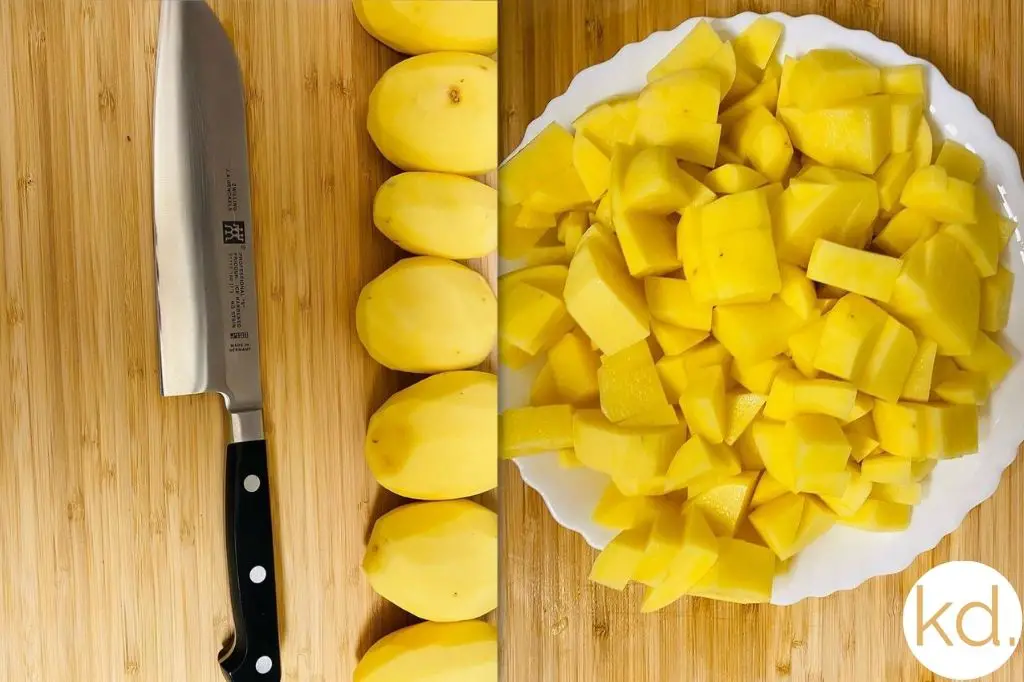
With its elegant shapes and high-quality materials, Zwilling J.A. Henckel’s have been pleasing chefs and home cooks for centuries. Here’s why: these knives’ blades possess state-of-the-art technology that exceeds expectations.
From German steel to Japanese know-how, each knife is subsequently crafted to give you the sharpest cutting edge and greatest durability. Furthermore, Classic, timeless designs are indistinguishable from those of knives made over a century ago.
Zwilling Pro has all the best features you want in a German kitchen knife. It has a thick blade, which is great for chopping; it has a wide blade, which is great for slicing; and it has a full tang, which is great for balance.
Check out our Review on Zwilling Knives
Quick Facts:
- Made: Solingen, Germany or Seki, Japan.
- Production: Sigma forge process control of laser technology for sharpening
- Blade: FRIODUR blade — it’s high carbon and rust-resistant.
- Handle: Colors and detail Varied collections
- Full tang: Full tang
- Edge angle: 15 degrees angle on both sides
- Warranty: Limited lifetime warranty
Pros
- Elegant Shape
- Great for chopping
- Wide Blade
- Synthetic handle offers perfect grip
- Great balance
Cons
- Costly as compared to Henckels Knives
Mercer Culinary Renaissance 8 Inch Chef Knife:

Created by the Mercer Culinary, this 8-inch chef’s knife is an essential piece of every kitchen. This knife features a German high-carbon stainless steel blade and a Delrin handle that offers great value and performance. The knife is ergonomically designed, ensuring comfort and safety when using it.
It’s not just any knife; it has gone through a tempering process that ensures its flexibility with the right amount of hardness.
Mercer Culinary has made several knives in different series, but the Renaissance line has proven to be efficient and unique in each way.
“I have been using these knives for 2 years now. They stay sharp and I do put them through the dishwasher and they come out great. I love the way they feel in my hand” Says – Noor Khadija Senior Editor at Kitchen Deets.
If you’d like to read more about Mercer Culinary Knives, Check out our article on Mercer Knives Review
Quick Facts:
- Made: Solingen, Germany or Taiwan
- Blade: High carbon stainless steel
- Handle Material: Delrin
- Full tang: Full tang
- Edge angle: 15 degrees angle on both sides
- Warranty: Limited lifetime warranty
Pros
- Unique beautiful design
- NSF certified
- High quality German knife that cuts and chops efficiently at an Affordable price.
- Corrosion and stain resistant blade
- Offers great value and performance
Cons
- Short bolster as compared to Wusthof Classic and Zwilling Professional S
Messermeister Meridian Elite Knife, 8-Inch:

Messermeister’s knives feature a forged style in Solingen, Germany. Traditionally, knives are forged from one piece of steel using intense pressure and heat. Messermeister uses this traditional forging method to shape its high-quality knives.
Messermeister makes some of the highest-quality kitchen knives in the business — and they’re not just high quality, their durability is legendary. They hot-drop their knives and hammer them into shape, making them tougher and far more robust than typical kitchenware on the market today.
This strong engineering is part of what makes Messermeister’s knives so durable, with a reputation for lasting years with minimal damage.
With a 30-degree edge that’s hard enough to cut through anything you throw at it, It is smooth enough to handle delicate ingredients like herbs and tomatoes without bruising them, these knives are undoubtedly the most useful knives you’ll ever own.
In short, Messermeister Meridian Elite Chef’s Knife is the Best German Knife.
Kitchen Deets
Quick Facts:
- Production: Traditional German process
- Blade: Smooth and Shiny finish
- Handle: It varies with collection, available in different colors
- Full tang: Full tang
- Edge angle: 15 degrees per side
- Warranty: Knife for life guarantee
Pros
- 30 Degree edge yet smooth enough to cut ingredients
- Ergonomic Design
- Durable enough to Last for years
Cons
- Slightly heavy
Gude Alpha Series 8-Inch Knife:

Gude Alpha Series 8-Inch Chef’s Knife is hand forged in Solingen, Germany, where the knife making industry originated centuries ago. Despite being over a thousand years old, the knife-making tradition in Solingen, Germany continues to flourish to this day.
First, the blanks of alloyed chrome-vanadium-molybdenum steel are manufactured to ensure their durability. Then, each blade goes through thirty different steps before completion: grinding, sharpening, cutting, and polishing.
The knife’s handle is made up of a specially-mixed plastic — offering exceptional hold without sacrificing comfort. With its German blacksmith-forged blade, it’s the perfect tool for cutting through any ingredient.
Alpha Chef Knife is heat-treated to ensure maximum hardness and corrosion resistance, making it particularly great for cutting meat. The ergonomic handle helps balance the weight of the blade to ease fatigue when using it in large cuts or long slicing sessions.
“Cutting with a Gude knife feels like a walk through the woods — you can feel the blade gently glide through meat and veggies” Says – Simon Lee Product Researcher/Tester at Kitchen Deets.
Check out our article on Gyuto vs Santoku Knife
Quick Facts:
- Made: Solingen, Germany
- Production: Thirty different steps including Sharpening, Grinding, Cutting
- Blade: chrome-vanadium-molybdenum cutlery steel blade.
- Handle Color: Black
- Full tang: Full tang
- Edge angle: 17 degrees angle on both sides
- Warranty: Limited lifetime warranty
Pros
- Uses chrome-vanadium-molybdenum steel
- Perfect for daily use
- Comfortable grip
- The grip is made of a robust plastic called Hostaform — which provides a special cutting experience
- Maximum hardness
Cons
- Heavy for few people
- Extremely thick
Cangshan S1 Series (59694) 8” inch German knife:

The Cangshan S1 knife series is one of the most popular and highly reviewed German knives in recent times. Made to be stain resistant, durable, and easy to sharpen, it’s everything you could want in a high-end knife.
Cangshan chef knives are handcrafted from X50CrMoV15 German steel, which is known for its strength and stain resistance. Each blade is heat treated to be strong and flexible, so it will last a lifetime. Additionally, Each piece is hand-sharpened to a 16 degree angle per side, which provides a sharp edge that can handle any prep task in the kitchen.
Ideal for home cooks and professionals alike, you can use this all purpose knife in daily kitchen tasks like chopping, slicing, and dicing, mincing.
It is fully certified for use in the United States by NSF International which means that the knife is free of harmful toxins like lead and mercury, and also comes with a lifetime guarantee against defects.
We have tested the knife under heavy use over two months and haven’t found any weakness to its cutting power. Read our full Review on Cangshan Knives
Kitchen Deets
Quick Facts:
- Made: China
- Production: Handcrafted
- Blade: High-alloy German X50CrMoV15 Steel.
- Handle Color: Skin
- Full tang: Full tang
- Edge angle: 16 degrees angle on both sides
- Warranty: lifetime guarantee against defects.
Pros
- handcrafted from X50CrMoV15 German steel
- Perfect to cut meat
- Certified by NSF International
- A lifetime guarantee against defects
- 15% chromium content gives the knife more durability and edge retention
- works well for medium duty cutting
- Lightweight and sharp
Cons
- Hand wash only
Check out our article on Most Expensive Kitchen Knives
Why You Should Choose German Chef Knives
The kitchen knife market is vast and complex, and the average consumer often finds themselves perplexed with the sheer number of different brands on offer. This is why you should avoid flimsy knives — and choose a high-quality branded knife.
German kitchen knives have:
- Blades that are built with precision hard stainless steel.
- The handles feature a comfortable, contoured design.
- Hand-sharpened blades are honed to stay sharp over time.
- Durable materials help ensure that the knives will last through many uses.
- High quality soft steel knives with full tang construction.
Through extensive research, we narrowed down the competition to Six different brands of kitchen knives, so you can find the perfect set for your home or business.
Frequently Asked Questions
What is the Best German Knife Brand?
There are many kitchen knife brands made in Germany but Wusthof and Zwilling are two of the top quality German knife brands. If you’re looking for high-quality cutlery that’ll last a lifetime, these two brands should be on your list.
Why are German Chef Knives Famous?
Germany has always been known for their quality, precision, level of detail and artistry that is embedded in the manufacture of some of their finest products. This also applies to German Chef knives as well because when you cook with a German knife you like to think that you can taste all the hard work and creation done by the German mind.
Which German Knives Have Full Tang Construction?
All the German knives in our list are made from one piece of metal (Full tang) instead of two separate parts that are joined together. This makes them stronger than other brands, which can break easily if dropped on the floor or slammed into something hard such as bone or stone.
Do German Knives Retain their Edge for Longer?
The steel used in German knives is made with a high carbon content and has been hardened through a process called quenching. This process ensures that the blade retains its edge for longer periods of time than other types of steel.
